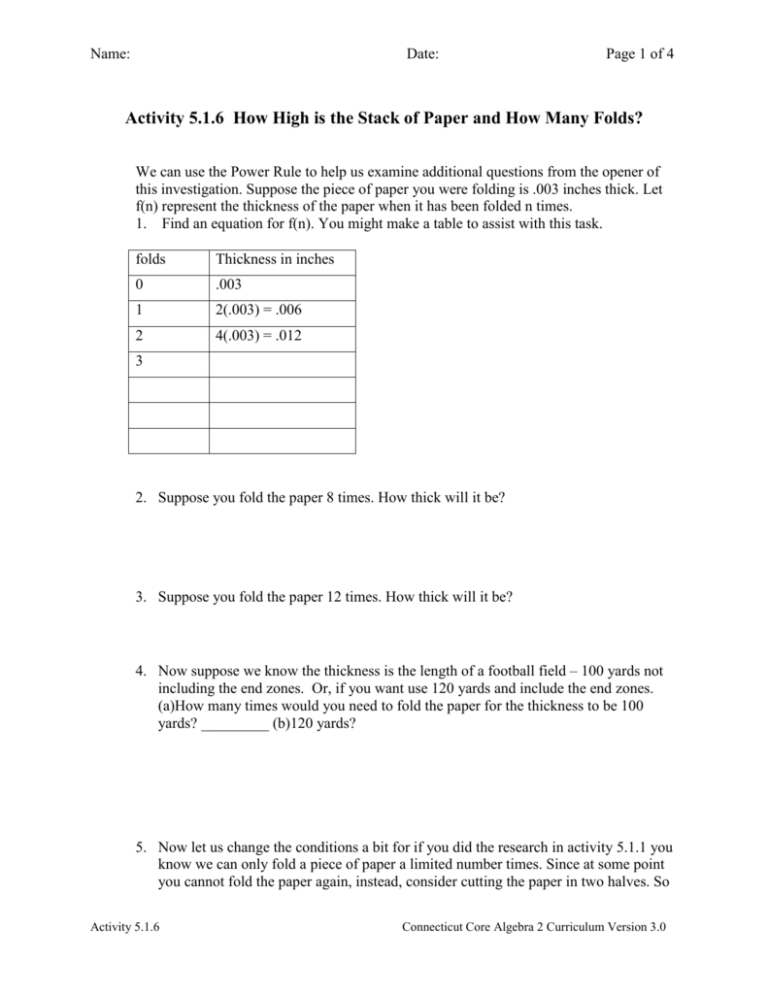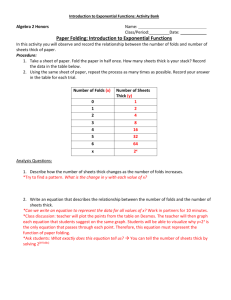Activity 5.1.6 How High is that Stack of Paper?
advertisement

Name: Date: Page 1 of 4 Activity 5.1.6 How High is the Stack of Paper and How Many Folds? We can use the Power Rule to help us examine additional questions from the opener of this investigation. Suppose the piece of paper you were folding is .003 inches thick. Let f(n) represent the thickness of the paper when it has been folded n times. 1. Find an equation for f(n). You might make a table to assist with this task. folds Thickness in inches 0 .003 1 2(.003) = .006 2 4(.003) = .012 3 2. Suppose you fold the paper 8 times. How thick will it be? 3. Suppose you fold the paper 12 times. How thick will it be? 4. Now suppose we know the thickness is the length of a football field – 100 yards not including the end zones. Or, if you want use 120 yards and include the end zones. (a)How many times would you need to fold the paper for the thickness to be 100 yards? _________ (b)120 yards? 5. Now let us change the conditions a bit for if you did the research in activity 5.1.1 you know we can only fold a piece of paper a limited number times. Since at some point you cannot fold the paper again, instead, consider cutting the paper in two halves. So Activity 5.1.6 Connecticut Core Algebra 2 Curriculum Version 3.0 Name: Date: Page 2 of 4 cut in half and then place one piece on top of the other. Repeat, cut in half, stack one half on top of the other to make a new stack. If the paper gets too thick for your scissor then cut fewer sheets at a time and then stack in one big pile. So you will have one sheet, then 2 sheets, 4 sheets, 8 sheets, and so on. Continue until you have cut in half 50 times. How high will the stack of paper be? Make an estimate here ______________ Be sure if the number of inches is large to convert to miles. _______________ 6. How far is it from the earth to the moon? _____________You may have to look this up. Look at your answer to 5 above. How many earth to moon distances is your stack of paper?______________ 7. Now look of the distance from the earth to the sun and write down here. ______________ How many cuts would you have to make to have a stack of paper that tall? _______________________ 8. The Power Rule for Logarithms lets us solve problems like 8x = 25. We take the log of both sides. Why can we do this? _______ We replace log 8x with x log 8 and have x log 8 = log 25 and divide both sides by the number log 8. So the solution is exactly (log 25)/(log 8). What is an approximate solution to two decimal places? _____ 9. Now try some yourself. a. 1.7x = 25 b. 0.5x = 11 Activity 5.1.6 Connecticut Core Algebra 2 Curriculum Version 3.0 Name: Date: Page 3 of 4 c. 1.7x + 4 = 25 d. 2 (1.7x) = 25 e. 1.7x/3 = 25 f. 1.72x = 25 g. 1.7(2x + 1) = 25 h. 4(1.8)x = 7(1.07)x 10. A teacher put the following problem on a quiz. Solve 9(2)x = 4(11)x. When she made her answer key she had log(9/4)/log(11/2) as the exact answer. As she continued to grade the papers a student had log(4/9)/log(2/11). Is this student correct? ___ Explain.____________________ As she continued to grade papers she also found (log 9 - log 4)/(log 11 – log 2). Should this last student receive credit? Explain. ____________________ 11. We can also use our ability to take the logarithm of both sides of an equation to find the logarithm of a number to any base. Find log 20 8. Let y = log 20 8. Then 20y = 8. Activity 5.1.6 Connecticut Core Algebra 2 Curriculum Version 3.0 Name: Date: Page 4 of 4 Now take the log of both sides. log 20y = log 8 and use the power rule. What is y? ________ Now check number 8 of activity 5.1.3 when you used trial and error to find log 20 8. Were you close? Now find log 2 75. Let y = log 2 75. Then 2y = 75. Finish the problem. __________ Now find log 𝑏 𝑐. Activity 5.1.6 Connecticut Core Algebra 2 Curriculum Version 3.0








